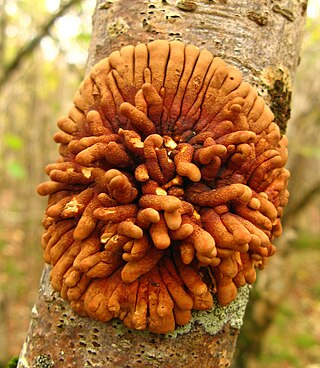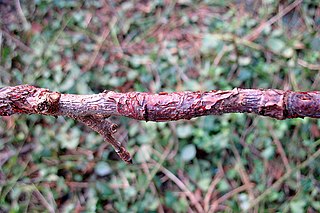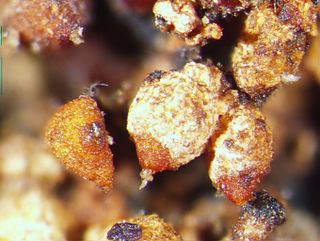Related Research Articles

The Hypocreales are an order of fungi within the class Sordariomycetes. In 2008, it was estimated that it contained some 237 genera, and 2647 species in seven families. Since then, a considerable number of further taxa have been identified, including an additional family, the Stachybotryaceae. Wijayawardene et al. in 2020 added more families and genera to the order. According to the Catalog of Life, As of April 2021 the Hypocreales contains 6 families, 137 genera, and 1411 species. Hyde et al. (2020a) listed 14 families under Hypocreales, while, Wijayawardene et al. (2022) accepted 15 families in the order, where Cylindriaceae was additionally added. Earlier, Hyde et al. (2020a) had placed Cylindriaceae in class Xylariomycetidae. Samarakoon et al. (2022) agreed. Hence, Cylindriaceae should have been excluded from Hypocreales and placed in Xylariomycetidae. Xiao et al. (2022) recently introduced a new family Polycephalomycetaceae to Hypocreales.

The Nectriaceae comprise a family of fungi in the order Hypocreales. It was circumscribed by brothers Charles and Louis René Tulasne in 1865. In 2020, an Outline of fungi was produced and listed 70 genera and about 1,336 species.
Hyponectria is a genus of fungi in the family Hyponectriaceae.

The Bionectriaceae are a family of fungi in the order Hypocreales. A 2008 estimate places 35 genera and 281 species in the family. Species in the family tend to grow on plant material, including woody debris, while some species associate with algae, bryophytes, or other fungi.
Dimerosporiella is a genus of fungi in the class Sordariomycetes.
Hydropisphaera is a genus of fungi in the class Sordariomycetes. It consisted of 18 species in 2008, and 32 species in 2023.
Lasionectria is a genus of fungi in the class Sordariomycetes. It consisted of six species in 2008, and 16 in 2023.
Protocreopsis is a genus of fungi in the class Sordariomycetes. It consisted of nine species in 2008, and up to 11 species in 2023.
Stephanonectria is a genus of fungi in the class Sordariomycetes. This was a monotypic genus, containing the single species Stephanonectria keithii until another species was added in 2023.
Trichonectria is a genus of fungi in the class Sordariomycetes.
Ascotaiwania is a genus of fungi in the Sordariomycetes class of the Ascomycota. In 2020, it was placed in the order Savoryellales and family of Savoryellaceae.
Cercophora is a genus of fungi which was within the Lasiosphaeriaceae family. As of 2020, it was placed into the Neoschizotheciaceae family.
Tubeufia is a genus in the Tubeufiaceae family of fungi.

Hypocreopsis is a genus of ascomycete fungi that form stromata on the stems of trees and shrubs. The stromata are orange-brown and consist of radiating, perithecial lobes.

Corallomycetella is a genus of ascomycete fungi in the family Nectriaceae. Species of Corallomycetella are tropical, and are characterized by the formation of brightly colored rhizomorphs of their rhizostilbella-like asexual morphs. These fungi causes a number of plant diseases including 'violet root rot' of Theobroma cacao, root rot of Carica papaya, and 'stinking root disease' of several tropical woody plants. Two species of Corallomycetella are recognized: Corallomycetella elegans C. Herrera & P. Chaverri and Corallomycetella repens Rossman & Samuels. Corallomycetella jatrophae is now classified under Corallonectria.

Cosmospora is a genus of ascomycete fungi in the family Nectriaceae. The genus, as circumscribed by Rossman et al. (1998), included all the nectrioid species with small, reddish, non-ornamented sexual fruiting bodies that collapse laterally when dry. However, the genus was shown to be polyphyletic, and the majority of species were re-classified into revived or recently established genera that are monophyletic. Cosmosporasensu Rossman housed members of the following genera: Chaetopsina, Cylindrocladiella, Fusicolla, Macroconia, Mariannaea, Microcera, Pseudocosmospora, Stylonectria, and Volutella. Cosmospora was restricted to species having acremonium-like asexual morphs that grow on polypores and xylariaceous fungi by Gräfenhan in 2011. About 20 species are accepted in the genus.

Neonectria is a genus of fungi in the family Nectriaceae. 'Outline of Fungi and fungus-like taxa' by Wijayawardene et al. lists up to 30 species, and around 25 records are listed by Species Fungorum.

Corallonectria is a genus of ascomycete fungi in the family Nectriaceae. Species of Corallonectria are Neotropical. These fungi are characterized by the formation of brightly colored rhizomorphs and of copulated synnematous fusarium-like asexual morphs in culture. The asexual morph in nature has been rarely observed. The sexual fruiting bodies are furfuraceous and usually seated at the base of a reddish synnemata. It is a monotypic genus containing the sole species Corallonectria jatrophae. This species was formerly classified under Corallomycetella.
Clonostachys is a genus of fungi in the order Hypocreales and family Bionectriaceae.
Gliomastix is a genus of fungi belonging to the family Bionectriaceae.
References
- ↑ Lumbsch TH, Huhndorf SM (December 2007). "Outline of Ascomycota – 2007". Myconet. Chicago, USA: The Field Museum, Department of Botany. 13: 1–58. Archived from the original on 2009-03-18.
- ↑ Kirk PM, Cannon PF, Minter DW, Stalpers JA (2008). Dictionary of the Fungi (10th ed.). Wallingford, UK: CAB International. p. 337. ISBN 0-85199-826-7.
- 1 2 3 "Species Fungorum - Search Page - Ijuhya". www.speciesfungorum.org. Retrieved 19 July 2023.